Thermometry & MR-HIFU
Oral
Interventional MRI
Thursday, 21 June 2018
| W05/06 |
13:15 - 15:15 |
Moderators: Pooja Gaur, Michael Bock |
13:15
|
1187.
 |
 Feasibility of Blood-Brain Barrier Opening in Patients with Alzheimer’s Disease by MR-Guided Focused Ultrasound Feasibility of Blood-Brain Barrier Opening in Patients with Alzheimer’s Disease by MR-Guided Focused Ultrasound
Yuexi Huang, Nir Lipsman, Ying Meng, Allison Bethune, Benjamin Lam, Mario Masellis, Nathan Herrmann, Chinthaka Heyn, Isabelle Aubert, Alexandre Boutet, Gwenn Smith, Sandra Black, Kullervo Hynynen
In a phase I clinical trial, the feasibility and safety of focal blood-brain barrier (BBB) opening in patients with Alzheimer’s disease using the ExAblate focused ultrasound system was evaluated. Six patients were treated in the white matter of the prefrontal cortex. It was demonstrated that BBB opening can be achieved without any red-blood-cell extravasation.
|
13:27
|
1188.
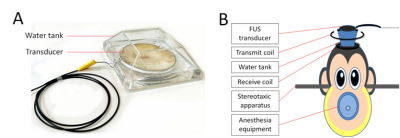 |
 Noninvasive neuromodulation induced by focused ultrasound combined with fMRI in the non-human primate brain Noninvasive neuromodulation induced by focused ultrasound combined with fMRI in the non-human primate brain
Tingting He#, Chih-Hung Tsai#, Ssu-Ju Li, Xianfeng Feng, Kaiyue Wang, Chao-Ting Wang, Xiao Yu, Wei Xiong, You-Yin Chen, Hao-Li Liu*, Hsin-Yi Lai*
Currently, the field of neuromodulation using focused ultrasound is growing due to its potential clinical applications. Using the lab-designed MRI-compatible FUS transducer and 7T research MRI system with the customer-made transmit/receive surface coil, the current study demonstrated that focused ultrasound (FUS) can induce BOLD responses in visual cortex in non-human primate. The effect of FUS could sostenuto influence the neuron activity in the visual cortex to enhance BOLD responses evoked by visual stimulus. FUS combined with fMRI has potential to explore the mechanism of neuromodulation in NHP induced by focused ultrasound.
|
13:39
|
1189.
 |
 In vivo MR-ARFI for transcranial focused ultrasound in large animals In vivo MR-ARFI for transcranial focused ultrasound in large animals
Pooja Gaur, Ningrui Li, Rachelle Bitton, Kim Butts Pauly
Focused ultrasound through the skull is desirable for noninvasive brain therapies such as neuromodulation. However, the skull distorts the ultrasound beam and absorbs varying amounts of energy depending on bone thickness and composition. In light of these challenges, we investigate magnetic resonance acoustic radiation force imaging (MR-ARFI) focal spot imaging of subcortical brain tissue in a large animal, and simulations and measurements of acoustic pressure transmitted through the skull. Results show in vivo MR-ARFI focal spot imaging through the skull for the first time, and provide practical information on focal spot targeting through skulls of varying shape, thickness, and composition.
|
13:51
|
1190.
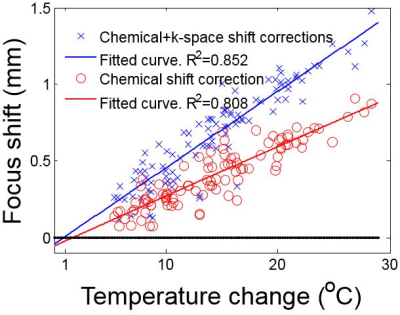 |
 Focus Correction in MR Thermometry for Precise Targeting in Focused Ultrasound Thalamotomy for Essential Tremor: Statistical Study from 121 Sonications in 7 Patients Focus Correction in MR Thermometry for Precise Targeting in Focused Ultrasound Thalamotomy for Essential Tremor: Statistical Study from 121 Sonications in 7 Patients
Chang-Sheng Mei, Shenyan Zong, Bruno Madore, Nathan McDannold
Focused ultrasound thalamotomy was approved by FDA for the treatment of essential tremor under MRI guidance. However, spatial errors in the location of focal spots are often observed and could jeopardize the patient safety if not taken into account. We previously explained the causes of this error and proposed a correction method. Using the method, data associated with 121 sonications from 7 patients were statistically analyzed in the present study. Results show the focus was shifted by 0.05 mm/°C. The size of shift for treating sonication agrees with the value reported in literature.
|
14:03
|
1191.
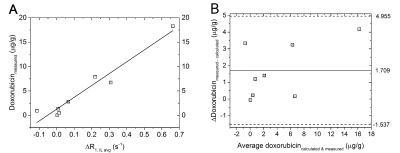 |
Interleaved scanning for MR-guided High Intensity Focused Ultrasound mediated drug delivery
Video Permission Withheld
Edwin Heijman, Esther Kneepkens, Jochen Keupp, Steffen Weiss, Holger Grüll
MR-guided High Intensity Focused Ultrasound (MR-HIFU) is a method that allows non-invasive heating of lesions to well-controlled ablative or hyperthermic temperatures. Control of acoustic power and focus position is achieved using a feedback based on MR thermometry. Local hyperthermia can be used as a trigger for image guided drug delivery using temperature sensitive liposomes co-encapsulating doxorubicin and MR contrast agent. The challenge is to acquire both temperature and R1-maps during hyperthermia dynamically. We investigated a novel MR method interleaving both acquisitions, with their own temporal resolution, without compromising temperature feedback showing a gradually increase of contrast agent inside rat tumors.
|
14:15
|
1192.
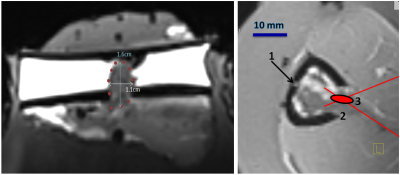 |
An experimental model for mild hyperthermia with predictive temperature control in osteolytic bone metastases, using MR-guided focused ultrasound.
Video Permission Withheld
Sana Boudabbous, Pauline Guillemin, Orane Lorton, Laura Gui-Levy, Stephane Desgranges, Xavier Montet, Christoph D Becker, Raymond Miralbell, Thomas Zilli, Rares Salomir
Combination of hyperthermia with ionizing radiation is strongly compelling, based on principles of classic radiobiology, molecular biology, and tumor physiology. MR-guided focused ultrasound (MRgFUS) is a “touch-less” approach already employed for ablative pain palliation of symptomatic bone metastases (SBM). MRgFUS mild hyperthermia adjuvant to radiation therapy has not been reported for SMB pain palliation. We optimized here the geometry of MRgFUS sonication and the automatic temperature control during steady-state long lasting hyperthermia using a realistic ex-vivo anatomic model mimicking osteolytic bone tumors. The results demonstrated uniform spatio-temporal heating, together with predictable and safe thermal condition of the cortical bone.
|
14:27
|
1193.
 |
 Correction of focused ultrasound beam defocusing in heterogeneous soft tissues Correction of focused ultrasound beam defocusing in heterogeneous soft tissues
Allison Payne, Henrik Odeen, Christopher Dillon, Hailey McLean, Douglas Christensen, Dennis Parker
Soft tissue MRgFUS treatments can be adversely affected by aberration of the focused ultrasound beam due to speed of sound differences between heterogeneous tissues. A quasi-real time beam aberration correction technique that uses an MRI derived model is presented and experimentally validated in a heterogeneous breast-mimicking phantom model. Comparison of MRgFUS sonications performed with and without phase aberration correction demonstrates that this model-based correction algorithm results in improved MRgFUS treatment efficiency and accuracy. This is shown to affect both thermal and mechanical MRgFUS applications.
|
14:39
|
1194.
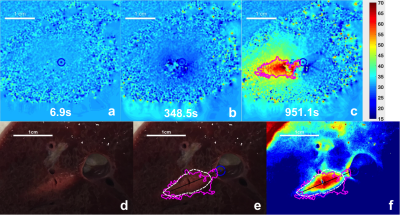 |
 Intra-vascular, MRI-Guided, perivascular ultrasound ablation with thermometric monitoring of therapy delivery Intra-vascular, MRI-Guided, perivascular ultrasound ablation with thermometric monitoring of therapy delivery
Xiaoyang Liu, Nicholas Ellens, Emery Williams, Clif Burdette, Parag Karmarkar, Paul Bottomley
Vessel invasion from a tumor is a major challenge for both surgical resection and extracorporeal HIFU ablation. Conceivably, an intravascular ultrasound ablation catheter combined with an intravascular high-resolution MRI coil could precisely target and monitor of peri-vascular therapy delivery that preserves the vessel wall via MRI thermometry. We present results from an intra-vascular 3T ultrasound ablation/MRI antenna probe that document MRI thermometry-based thermal dosage and lesion formation in porcine liver and chicken specimens with vessel wall preservation. A simple motion-correction method that employs the antenna’s intrinsic sensitivity profile as a navigator for thermometry is tested in vivo.
|
14:51
|
1195.
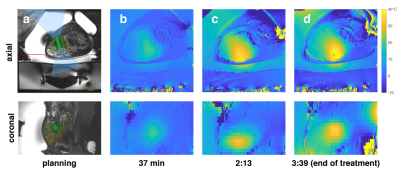 |
 Long-Term Volumetric Thermometry for Measurement of Diffuse Tissue Heating during MRgFUS Treatments Long-Term Volumetric Thermometry for Measurement of Diffuse Tissue Heating during MRgFUS Treatments
Eugene Ozhinsky, Matthew Bucknor, Viola Rieke
Currently, PRF MR thermometry is commonly used for temperature monitoring and thermal dose estimation during MRgFUS treatments. The temperature is calculated based on the phase change between the current image and the baseline image, which is acquired before each sonication starts. This does not account for residual heat from previous sonications. In this work, we have developed a volumetric long-term thermometry technique to measure the change in temperature of the entire region of treatment for the duration of the procedure
|
15:03
|
1196.
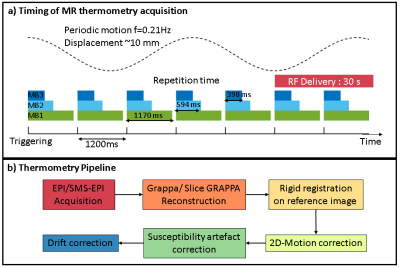 |
 Evaluation of 2D simultaneous multi-slice EPI at 1.5T for MR-thermometry in presence of motion. Evaluation of 2D simultaneous multi-slice EPI at 1.5T for MR-thermometry in presence of motion.
Valéry Ozenne, Pierre Bour, Baudouin Denis De Senneville, Marylene Delcey, Wadie Ben Hassen, Alexis Vaussy, Rainer Schneider, Bruno Quesson
Temperature mapping in presence of respiratory motion can accommodate intra-scan motion using fast 2D-EPI sequence but inter-scan motion remains a challenge during free-breathing acquisition. To address this limitation, we evaluated, in vitro on a mobile gel, a 2D simultaneous multi-slice EPI sequence with a slice acceleration factor up to 3 during radiofrequency ablation. Inter-scan motion and temperature elevation measured with accelerated sequences are compared to reference values using a non-accelerated sequence. Additionally, evidence or absence of potential false-positive heating are considered.
|
|











